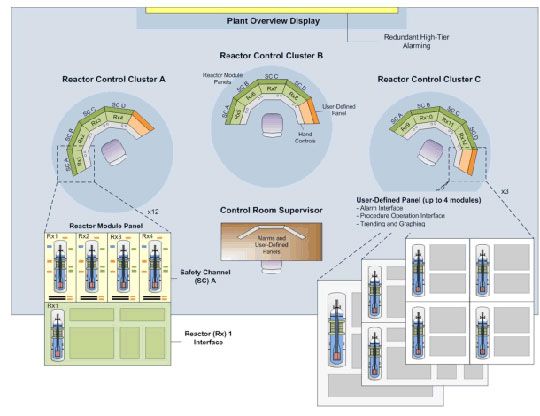If you want to learn more about small nuclear power plants and live in Seattle, Monday is your day.
The Grays Harbor PUD will hold a meeting next week to discuss the feasibility and potential of deploying small-scale nuclear power plants in the area. And the discussion in part will likely focus on NuScale Power.
Spun out of Oregon State in 2007, NuScale wants to build light water nuclear reactors that can produce approximately 40 megawatts of electricity or 150 megawatts of thermal power. The systems are small-the reactor vessel measures 14 feet in diameter and comes encased in a 60-foot long container made from three-inch thick steel-but they can be deployed in arrays of up to 24 reactors if necessary.
A single integrated reactor will weigh about 300 tons. The reactor will use six foot fuel rods instead of the standard 12 foot rods, according to the company's website. (We've played phone tag with NuScale for several days.)
The reactor will largely be built from standard or slightly modified components currently used in the nuclear industry, which, ideally, will simplify construction.
The key selling point, however, is that the water to cool the reactor circulates passively, which eliminates the need for pumps and reduces the demand for external power. More importantly, the absence of pumps greatly reduces the chance of a "loss of coolant accident." The coolant, along with the reactor, is effectively sealed inside of the 60-foot steel container.
While NuScale is expected to be at the hearing because of previous activity with utilities in the area, the company may not be alone or be the only one mentioned. Hyperion Power Generation, spun out of Los Alamos Nuclear Lab, has been touting the idea of small reactors for over a year.
TerraPower, a startup created inside Intellectual Ventures, the incubator founded by former Microsoft chief scientist Nathan Myhrvold, is trying to build small scale nuclear reactor that relies on depleted uranium, the waste product of current nuclear plants. Babcock & Wilcox, which has built nuclear reactors for decades, has also entered the market for micro nukes.
Hyperion's proposed reactor has about half of the power capacity, but is about the size of a hot tub. NuScale's power plant would need to be refueled every two years. Hyperion says it would need refueling every five years. TerraPower wants to bury its reactor for 30 to 60 years without opening it.
Energy Northwest, a joint operating agency of utilities in the Northwest, has been preparing a report since the beginning of the year on small, modular reactors. NuScale CEO Paul Lorenzini made a presentation to the Energy Northwest Board of Directors in January.
Lorenzini stated at the hearing that the costs, in 2007 dollars, of a complete NuScale power plant that could put out 500 megawatts of electricity would come to $3,500 to $4,500 per kilowatt and costs would decline as the overall size of the power plant would increase. (A 500-megawatt power plant presumably would consist of at least 13 modular 40-megawatt reactors.)
Such a plant could become operational within four and a half years after the first cement is poured.
NuScale hopes to submit design certification documents to the Nuclear Regulatory Commission by the end of 2010.
Although it hasn't received the same amount of publicity as Hyperion or even the more silent TerraPower, it has connections. The company can trace its history back to a research project kicked off by the Department of Energy that began in 2003. The work then transferred to Oregon State.
In April 2008, it signed a memorandum of understanding with Kiewit Power Constructors, one of the major contractors for power plants. In April of this year, Tom Marcille, formerly the chief engineer for advanced reactors at Los Alamos National Laboratory, joined the company. NuScale also said that in 2008 it demonstrated it could make the necessary components for its reactor in the U.S. It also shared safety data with leading experts.
CMEA, the high-science Silicon Valley VC firm, is an investor.
The Grays Harbor hearing may also delve into the issue of how or whether to deploy modular reactors for grid power. Hyperion mostly has talked about deploying its reactors at military bases, mines and distant communities. The meeting notice for Grays Harbor says:
"Grays Harbor PUD is looking toward the future, planning now for the energy we will need to serve our customers tomorrow. That means looking at different types of technology for clean energy resources."
At the January meeting at Energy Northwest, Lorenzini stated that the agency's report could possibly serve as a basis for an application to "construct and operate a power plant in the Tri-Cities."
Click image to enlarge.



